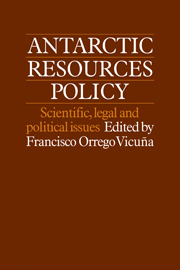Book contents
- Frontmatter
- Contents
- List of contributors
- 1 Antarctic resources policy: an introduction
- Part one The state of Antarctic knowledge and experience
- Part two The policy for the conservation of the living resources of Antarctica
- Part three The policy for the exploration and exploitation of the mineral resources of Antarctica
- Part four Issues on Antarctica and the law of the sea
- 17 The application of the law of the sea to the Antarctic continent
- 18 The application of the law of the sea and the exclusive economic zone to the Antarctic continent
- 19 The continental shelf of Antarctica: legal implications for a regime on mineral resources
- Part five The policy for Antarctic cooperation
18 - The application of the law of the sea and the exclusive economic zone to the Antarctic continent
Published online by Cambridge University Press: 06 July 2010
- Frontmatter
- Contents
- List of contributors
- 1 Antarctic resources policy: an introduction
- Part one The state of Antarctic knowledge and experience
- Part two The policy for the conservation of the living resources of Antarctica
- Part three The policy for the exploration and exploitation of the mineral resources of Antarctica
- Part four Issues on Antarctica and the law of the sea
- 17 The application of the law of the sea to the Antarctic continent
- 18 The application of the law of the sea and the exclusive economic zone to the Antarctic continent
- 19 The continental shelf of Antarctica: legal implications for a regime on mineral resources
- Part five The policy for Antarctic cooperation
Summary
Antarctic development and the marine environment
The growth in recent decades of scientific research focusing on Antarctica and the continent's continually improving accessibility, with air routes now open virtually year-round, have together with other factors placed Antarctica's resources increasingly in the spotlight. The Consultative Parties to the Antarctic Treaty, as well as other signatory countries of the Treaty and even non-signatory countries have been expressing their interest in this area, while the progress of technological development has proceeded without interruption.
Given the continent's geographic and climatic conditions, the development of its resources is intimately associated with the marine environment, for it is here that resources can most immediately be tapped, although great technological, economic and environmental difficulties will nonetheless have to be overcome. To the traditional activities of whaling and sealing, which are essentially marine activities, fishing has now been added. So far as the development of mineral resources is concerned, the major prospects also centre on Antarctica's continental shelf, not counting the fields of manganese nodules and other sea-bed resources also found in the area covered by the Treaty. Even the possible utilisation of icebergs is an activity involving the marine environment.
The regulatory instruments that have been approved, whether based on recommendations emerging from the consultative meetings or from special international conferences, for the most part relate to the marine environment. This is the case, for example, of the Agreed Measures for the Conservation of Antarctic Flora and Fauna, the Convention on the Whale, the Convention for the Conservation of Antarctic Seals, and more recently the Convention on the Conservation of Antarctic Marine Living Resources.
- Type
- Chapter
- Information
- Antarctic Resources PolicyScientific, Legal and Political Issues, pp. 243 - 252Publisher: Cambridge University PressPrint publication year: 1983

